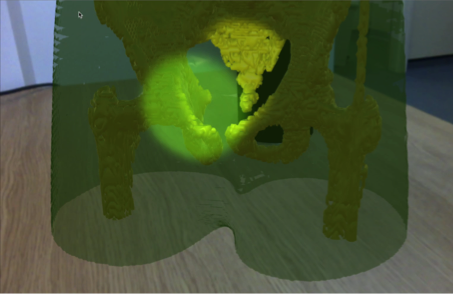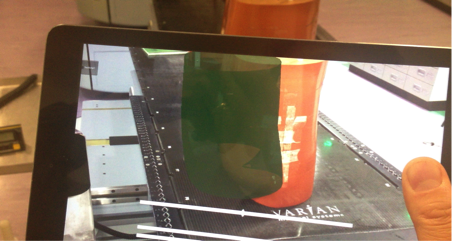We have developed an augmented reality tool for radiotherapy to view the real world scene, i.e. the patient on a treatment couch, combined with computer graphics content, such as planning image data and any defined outlines of organ structures. We have deployed our software to a number of consumer electronics devices (iPad, Android tablets, MS HoloLens). Due to the wide availability and low cost of the hardware platforms considered, associated with their increasing computational and graphic power, our system has strong potential as a tool for visualization of medical information for clinicians and other radiotherapy professionals, as a device for patient positioning for radiotherapy treatment, and as an educational tool for patients to visualize their treatment and demonstrate to patients e.g. the importance of compliance with instructions around bladder filling and rectal suppositories. Accuracy of virtual content placement and user evaluation of our system has been experimentally investigated.

An experimental evaluation of reproducibility of patient positioning using radarRAD-AR has been performed using an anthropomorphic phantom deigned for radiotherapy quality control (RANDO, RSD Inc.) that was CT scanned on our Widebore scanner (Philips, Brilliance), using our clinical protocol for early prostate treatments (3 mm thickness, pitch 1). We performed a preliminary study of precision for both the iPad and the HoloLens versions of RAD-AR.


The CT outline of the RANDO was positioned on the treatment couch as AR content. The physical phantom was then aligned to its AR outline. Precision of couch positions was 1 cm for the iPad and 1.5 cm for the HoloLens. Precision of couch angle was 3° for the iPad and 4° for the HoloLens. Precision of the iPad implementation of RAD-AR is higher than precision for the HoloLens version. This can be explained considering that in the iPad implementation, built on Vuforia, self-tracking is marker based and the AR content was placed close to the marker at approximately 30 cm (we used a cylinder marker – 5 cm radius, 12 cm height). For the HoloLens self tracking is based on environment mapping and the AR content is at a greater distance from the main tracking elements (walls, floor).
Collaborators: North Wales Cancer Treatment Centre, Bodelwyddan